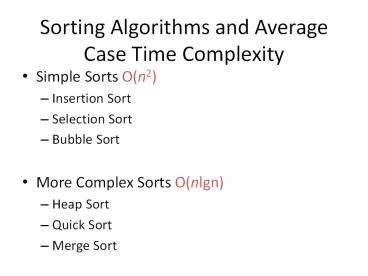Sorting Algorithms and Average Case Time Complexity - PowerPoint PPT Presentation
1 / 24
Title:
Sorting Algorithms and Average Case Time Complexity
Description:
Simple Sorts O(n2) Insertion Sort Selection Sort Bubble Sort More Complex Sorts O(nlgn) Heap Sort Quick Sort Merge Sort Heap Sort Remember the heap data structure . . . – PowerPoint PPT presentation
Number of Views:970
Avg rating:3.0/5.0
Title: Sorting Algorithms and Average Case Time Complexity
1
Sorting Algorithms and Average Case Time
Complexity
- Simple Sorts O(n2)
- Insertion Sort
- Selection Sort
- Bubble Sort
- More Complex Sorts O(nlgn)
- Heap Sort
- Quick Sort
- Merge Sort
2
Heap Sort
- Remember the heap data structure . . .
- Binary heap
- a binary tree that is
- Complete
- satisfies the heap property
3
Heap Sort (contd)
- Given an array of integers
- First, use MakeHeap to convert the array into a
max-heap. - Then, repeat the following steps until there are
no more unsorted elements - Take the root (maximum) element off the heap by
swapping it into its correct place in the array
at the end of the unsorted elements - Heapify the remaining unsorted elements (This
puts the next-largest element into the root
position)
4
Heap Sort (contd)
- HeapSort(A, n)
- MakeHeap(A)
- for i n downto 2
- exchange A1 with Ai
- n n-1
- Heapify(A,1)
5
Heapsort Example
- 2 8 6 1 10 15 12 11
6
Heap Sort (contd)
- Time complexity?
- First, MakeHeap(A)
- Easy analysis O(nlgn) since Heapify is O(lgn)
- More exact analysis O(n)
- Then
- n-1 swaps O(n)
- n-1 calls to Heapify O(nlgn)
- ? O(n) O(n) O(nlgn) O(nlgn)
7
Other Sorting Ideas
- Divide and Conquer!
8
Quicksort
- Recursive in nature.
- First Partition the array, and recursively
quicksort the subarray separately until the whole
array is sorted - This process of partitioning is carried down
until there are only one-cell arrays that do not
need to be sorted at all
9
Quicksort Algorithm
- Given an array of integers
- If array only contains one element, return
- Else
- Pick one element to use as the pivot
- Partition elements into 2 subarrays
- Elements less than or equal to the pivot
- Elements greater than or equal to the pivot
- Quicksort the two subarrays
10
Quicksort Example
11
Quicksort Example
- There are a number of ways to pick the pivot
element. Here, we will use the first element in
the array
12
Quicksort Partition
- Given a pivot, partition the elements of the
array such that the resulting array consists of - One sub-array that contains elements lt pivot
- Another sub-array that contains elements gt pivot
- The sub-arrays are stored in the original array
- Partitioning loops through, swapping elements
below/above pivot
13
Quicksort Example Partition Result
14
QuickSort
templateltclass Tgt void quicksort(T data, int
first, int last) //partition such that left
lt pivot, right gt pivot int lower first1,
upper last swap(datafirst,data(firstlas
t)/2) T pivot datafirst while
(lower lt upper) //find the position of the
first gt pivot element on the left while
(datalower lt pivot) lower
//find the position of the first lt pivot element
on the right while (pivot lt dataupper)
upper-- if (lower lt upper)
swap(datalower,dataupper--)
else lower swap(dataupper,data
first) if (first lt upper-1)
quicksort (data,first,upper-1) //quicksort
left if (upper1 lt last) quicksort
(data,upper1,last) //quicksort right
15
Quicksort - Recursion
- Recursion Quicksort sub-arrays
16
Quicksort Worst Case Complexity
- Worst case running time?
- Assume first element is chosen as pivot.
- Assume array is already in order
lt
Recursion 1. Partition splits array in two
sub-arrays one sub-array of size 0 the other
sub-array of size n-1 2. Quicksort each
sub-array Depth of recursion tree? O(n)
Number of accesses per partition? O(n)
17
Quicksort Best Case Complexity
- Assume that keys are random, uniformly
distributed. - Best case running time O(n log2n)
18
Merge Sort
- Quicksort worst case complexity in the worst
case is O(n2) because it is difficult to control
the partitioning process - The partitioning depends on the choice of pivot,
no guarantee that partitioning will result in
arrays of approximately equal size - Another strategy is to make partitioning as
simple as possible and concentrate on merging
sorted (sub)arrays
19
Merge Sort
- Also recursive in nature
- Given an array of integers, apply the
divide-and-conquer paradigm - Divide the n-element array into two subarrays of
n/2 elements each - Sort the two subarrays recursively using Merge
Sort - Merge the two subarrays to produce the sorted
array - The recursion stops when the array to be sorted
has length 1
20
Merge Sort
- Merge Sort
- Divide array into two halves
- Recursively sort each half
- Merge two halves to make sorted whole
21
Merging
- Merging Combine two pre-sorted lists into a
sorted whole - How to merge efficiently?
- Use temporary array
- Need index 1 (for array 1), index 2 (for array
2), 3 (for array tmp)
1
3
19
25
5
7
8
9
29
3
5
7
1
22
Merging
- Merge(A, left, middle, right)
- Create temporary array temp, same size as A
- i1 left
- i2 middle
- i3 0
- while ((i1 ! middle) (i2 ! right))
- if (Ai1 lt Ai2)
- tempi3 Ai1
- else tempi3 Ai2
- copy into temp remaining elements of A
- copy into A the contents of temp
23
Merging
- Time Complexity Analysis
- T(n) c1 if n 1
- T(n) 2 T(n/2) c2n
divide
O(1)
sort
2T(n/2)
merge
O(n)
24
Merge Sort
- MergeSort(A, left, right)
- if (left lt right)
- middle ?(left right)/2?
- MergeSort(A, left, middle)
- MergeSort(A, middle1, right)
- Merge(A, left, middle1, right)






























